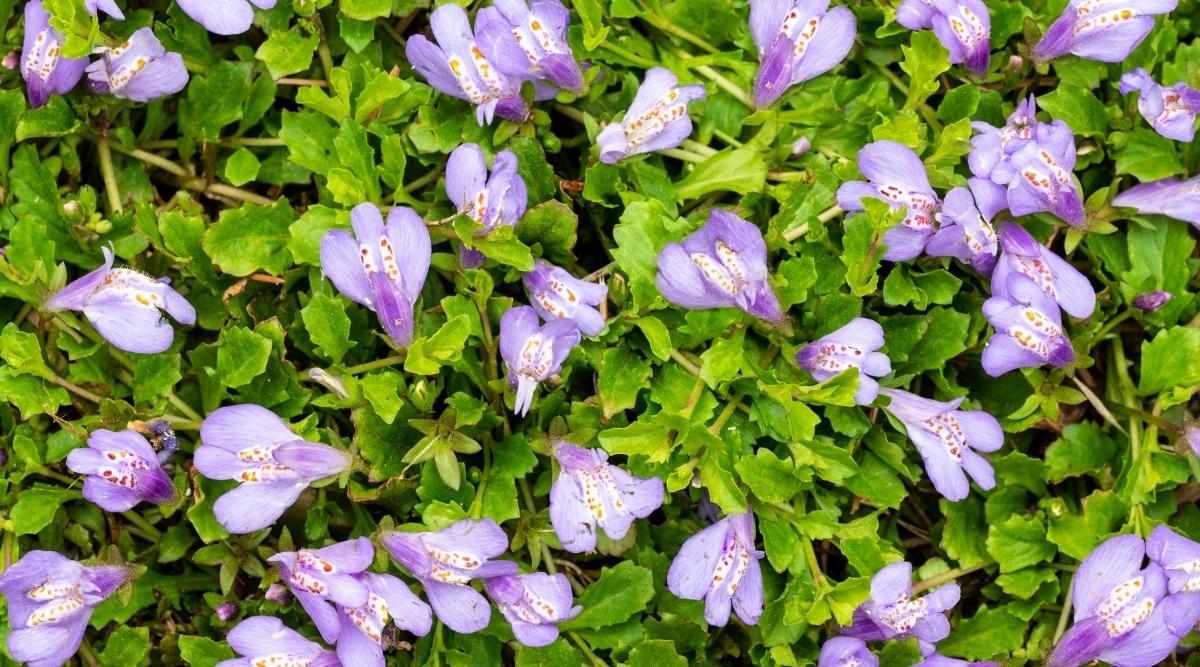nagoyasuzukiamerica.com – Creeping Mazus (Mazus reptans) is a low-growing, fast-spreading perennial known for its lush green foliage and vibrant, eye-catching flowers. This versatile plant is an excellent choice for gardeners looking for a beautiful groundcover that provides seasonal color, attracts pollinators, and requires minimal maintenance. With its ability to thrive in a variety of conditions, Creeping Mazus is ideal for filling in gaps, covering slopes, or enhancing the beauty of garden beds.
Description and Features
Creeping Mazus is a compact groundcover that grows to a height of just 2 to 4 inches, making it perfect for planting between stepping stones, along borders, or in areas where a low-maintenance, spreading plant is desired. The plant produces a dense mat of dark green, glossy leaves that are oval-shaped and slightly serrated. The foliage remains attractive throughout the growing season, offering a rich contrast to other plants in the garden.
The most striking feature of Creeping Mazus, however, is its flowers. Blooming in late spring to early summer, the small flowers are typically purple, blue, or white, and they grow in clusters on short, upright stems. The flowers have a tubular shape and are adorned with distinct markings, making them highly attractive to pollinators like bees and butterflies. These blooms provide a burst of color to the garden and last for several weeks, enhancing the beauty of the plant.
Creeping Mazus spreads quickly by sending out runners, forming a dense carpet of foliage and flowers that effectively suppresses weeds. It is well-suited to groundcover roles, filling in large areas with minimal effort.
Habitat and Distribution
Creeping Mazus is native to East Asia, particularly Japan, China, and Korea, where it thrives in a variety of environments, including meadows, forest edges, and stream banks. In cultivated gardens, Creeping Mazus performs well in moist, well-drained soil and prefers full sun to partial shade. While it can tolerate some shade, it typically produces the best blooms in sunnier locations.
The plant is ideal for use in garden beds, rock gardens, or as a groundcover on slopes, where it can help prevent soil erosion. It can also be grown in containers, where it spills over the edges with its cascading growth habit, adding beauty to patios, balconies, and hanging baskets.
Ecological Importance
Creeping Mazus is an excellent plant for attracting pollinators. Its flowers are rich in nectar, making them a valuable food source for bees, butterflies, and other beneficial insects. By supporting pollinator populations, Creeping Mazus plays an important role in promoting biodiversity and enhancing garden ecosystems.
The plant also helps to maintain soil health by forming a dense mat that prevents weed growth and retains moisture in the soil. This makes Creeping Mazus a useful addition to low-maintenance and sustainable gardens. Additionally, its spreading habit and ability to grow in a range of soil types make it ideal for erosion control on slopes and embankments.
Cultivation and Care
Creeping Mazus is relatively easy to grow and care for, making it an excellent choice for both novice and experienced gardeners. It thrives in well-drained soil that is kept moist but not waterlogged. While it can tolerate dry conditions once established, it prefers consistent moisture, especially during dry spells in the summer.
The plant does well in full sun or partial shade, though it will flower more prolifically in sunnier locations. Creeping Mazus is typically hardy in USDA zones 4 through 9, and it can tolerate a variety of soil types, from sandy to loamy, as long as they are well-draining.
To maintain the health and appearance of Creeping Mazus, it is recommended to trim back any spent flowers and remove any dead or damaged foliage. This will help the plant maintain a neat appearance and encourage new growth. Creeping Mazus is also relatively pest- and disease-resistant, though it may occasionally suffer from fungal infections in overly wet conditions.
For propagation, Creeping Mazus can be grown from seed, division, or by taking cuttings from established plants. Because of its spreading growth habit, it is often propagated by division in early spring or fall, ensuring that each section of the plant has healthy roots to grow and expand.
Symbolism and Cultural Significance
While Creeping Mazus is not widely known for its symbolism in the language of flowers, its qualities of resilience, beauty, and ease of growth make it a popular choice for gardeners seeking to convey a sense of tranquility and natural beauty. In its native regions, Creeping Mazus is appreciated for its ability to thrive in diverse environments and for its role in enhancing the natural landscape.
The plant’s dense foliage and vibrant blooms also make it a symbol of abundance and growth, as it can quickly fill in areas and provide an aesthetically pleasing solution for garden design.
Conclusion
Creeping Mazus is a versatile and charming perennial that offers an array of benefits for gardens and landscapes. With its attractive foliage, vibrant flowers, and ability to thrive in a variety of conditions, this low-maintenance plant is perfect for groundcover, rock gardens, and containers. Its ability to attract pollinators, suppress weeds, and control soil erosion makes it an excellent choice for sustainable and eco-friendly gardens. Whether used to fill in gaps, cover slopes, or enhance the beauty of garden beds, Creeping Mazus continues to be a favorite among gardeners looking for a hardy and beautiful addition to their landscapes.
